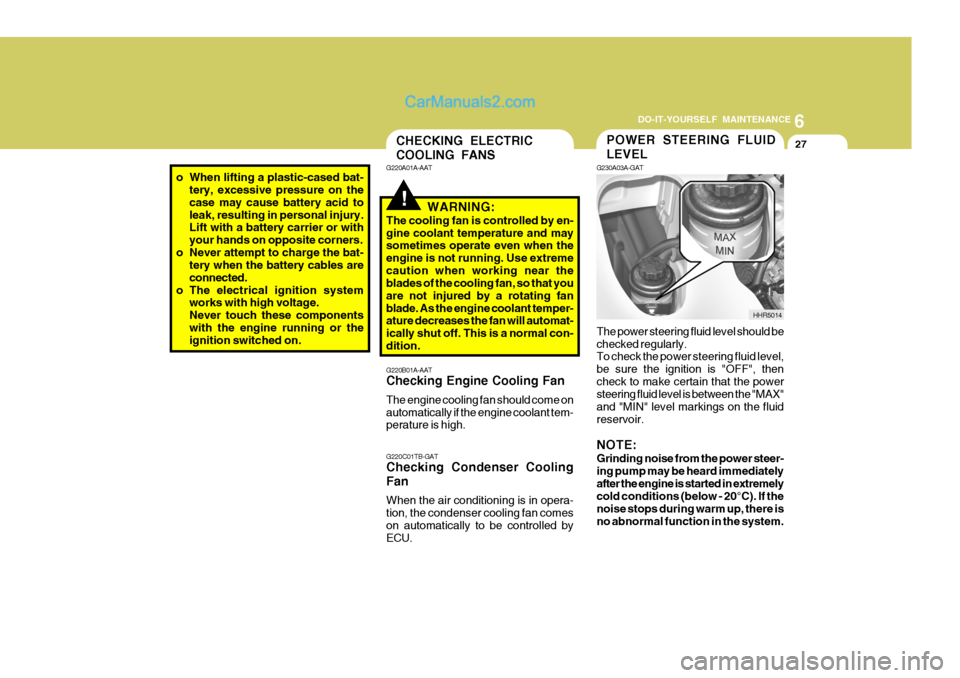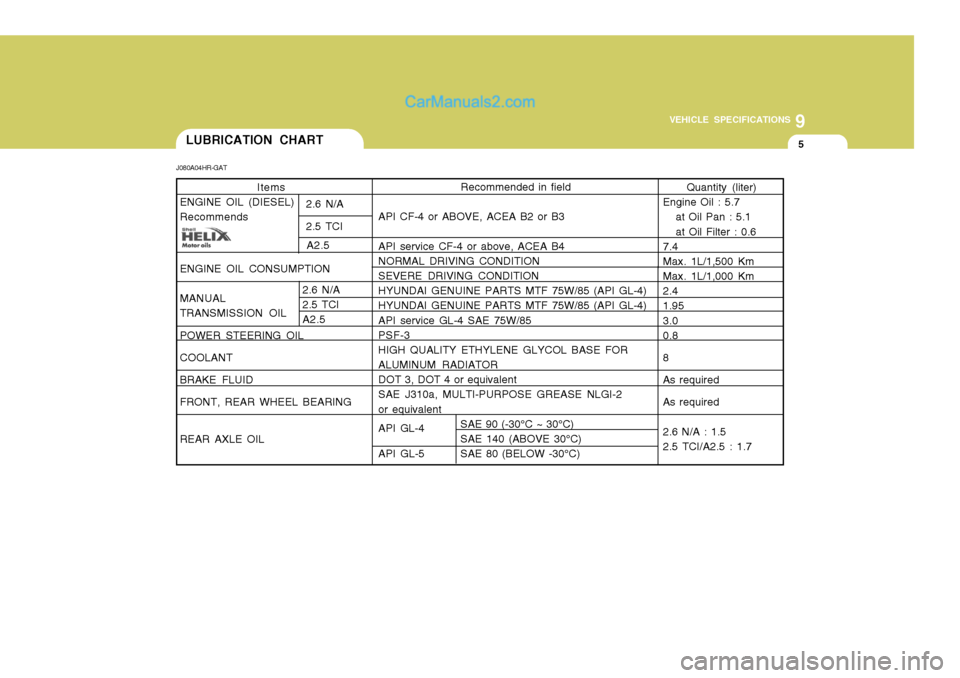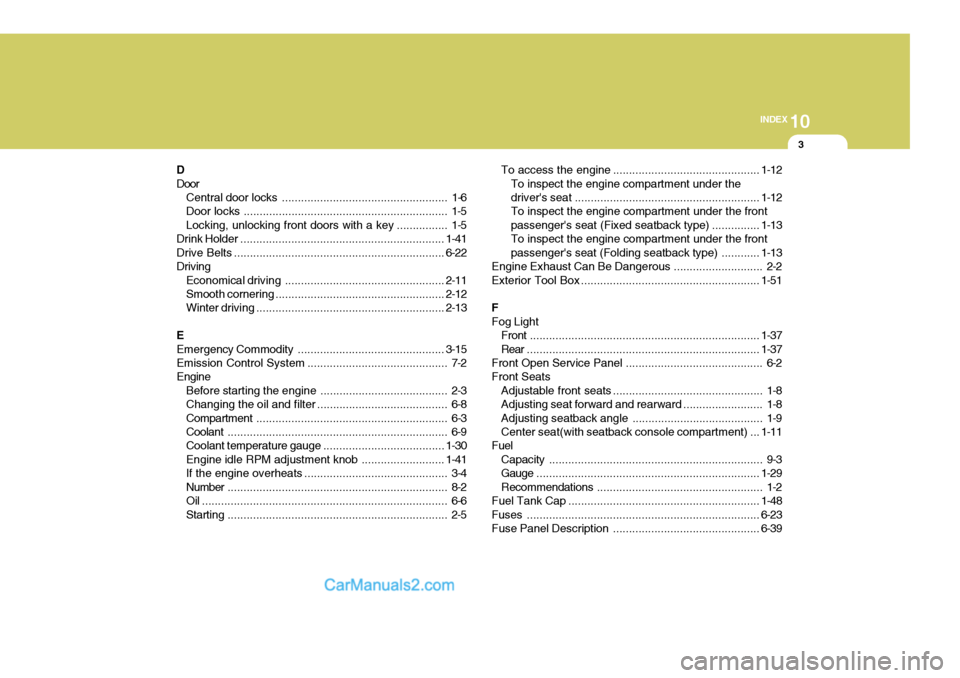2012 Hyundai H-100 Truck engine coolant
[x] Cancel search: engine coolantPage 164 of 217

6 DO-IT-YOURSELF MAINTENANCE
12
!WARNING:
6. Start the engine, top off the radiator with water, open the hood and then add engine coolant to the reservoir until the level is between "L" and "F".
7. Replace the radiator and reservoir
caps and check to be sure the draincocks are fully closed and not leak- ing.
3. Be sure your drain receptacle is inplace. Open the drain cock on the radiator. Allow all the engine coolantto drain from the cooling system, then securely close the drain cock.
4. Check Section 9 for the capacity of
the cooling system in your car. Then,following the manufacturer's direc- tions on the engine coolant contain-er, add the appropriate quantity of coolant to the radiator.
5. Fill the radiator with clean demineral-
ized or distilled water. Continue toadd clean demineralized or distilled water in small quantities until thefluid level stays up in the radiator neck. G050D02HR
!WARNING:
Do not remove the radia- tor cap when the engine and radiator are hot. Scalding hot coolant andsteam may blow out un- der pressure causing se- rious injury.The electric motor (cool- ing fan) is controlled by engine coolant tempera- ture, refrigerant pressure
and vehicle speed. It may some-times operate even when the engineis not running. Use extreme caution when working near the blades of the cooling fan so that you are not in-jured by a rotating fan blades. As the engine coolant temperature de- creases, the electric motor will auto-matically shut off. This is a normal condition.
Page 179 of 217

6
DO-IT-YOURSELF MAINTENANCE
27POWER STEERING FLUID LEVEL
G230A03A-GAT The power steering fluid level should be checked regularly. To check the power steering fluid level, be sure the ignition is "OFF", thencheck to make certain that the power steering fluid level is between the "MAX" and "MIN" level markings on the fluidreservoir. NOTE: Grinding noise from the power steer- ing pump may be heard immediatelyafter the engine is started in extremely cold conditions (below - 20°C). If the noise stops during warm up, there isno abnormal function in the system. HHR5014CHECKING ELECTRIC COOLING FANS
!
G220B01A-AAT Checking Engine Cooling Fan The engine cooling fan should come on automatically if the engine coolant tem- perature is high. G220C01TB-GAT Checking Condenser Cooling Fan When the air conditioning is in opera- tion, the condenser cooling fan comeson automatically to be controlled by ECU.
G220A01A-AAT
WARNING:
The cooling fan is controlled by en- gine coolant temperature and may sometimes operate even when the engine is not running. Use extremecaution when working near the blades of the cooling fan, so that you are not injured by a rotating fanblade. As the engine coolant temper- ature decreases the fan will automat- ically shut off. This is a normal con-dition.
o When lifting a plastic-cased bat- tery, excessive pressure on the case may cause battery acid toleak, resulting in personal injury. Lift with a battery carrier or with your hands on opposite corners.
o Never attempt to charge the bat- tery when the battery cables areconnected.
o The electrical ignition system works with high voltage.Never touch these componentswith the engine running or the ignition switched on.
Page 182 of 217

6 DO-IT-YOURSELF MAINTENANCE
30
!WARNING:
o Do not smoke or have any other open flame near the vehicle while bleeding the fuel system.
o Be sure to carefully wipe away any
water drained out in this manner,because the fuel mixed in the wa- ter might be ignited and result in a fire.
HEADLIGHT AIMING ADJUSTMENT
7. Adjust each cut-off line of the lowbeam to the parallel line with a phillips screwdriver - VERTICAL AIMING.
8. Adjust each cut-off line of the low beam to each vertical line with a phillips screwdriver - HORIZONTALAIMING. G290A01HR
Horizontal aiming
Vertical aiming
G290A01FC-GAT Before performing aiming adjustment, make sure of the following.
1. Keep all tires inflated to the correct
pressure.
2. Place the vehicle on level ground
and press the front bumper and rear bumper down several times. Place the vehicle at a distance of 3,000 mm (118 in.) from the test wall.
3. See that the vehicle is unloaded (except for full levels of coolant,engine oil and fuel, and spare tire,jack, and tools).
4. Clean the head lights lens and turn
on the headlight (low beam).
5. Open the hood.
6. Draw the vertical line (through the
center of each headlight beam pat- tern) and the horizontal line (through the center of each headlight beam pattern) on the aiming screen. And then, draw a horizontal parallel line at 30 mm (1.18 in.) under thehorizontal line.
NOTE: It is recommended that water accu- mulated in the fuel filter should be removed by an authorized Hyundaidealer.
Page 211 of 217

9
VEHICLE SPECIFICATIONS
5
Items
ENGINE OIL (DIESEL) Recommends ENGINE OIL CONSUMPTION MANUAL TRANSMISSION OIL POWER STEERING OIL COOLANT BRAKE FLUID FRONT, REAR WHEEL BEARING REAR AXLE OIL A2.5
LUBRICATION CHART
Recommended in field
API CF-4 or ABOVE, ACEA B2 or B3 API service CF-4 or above, ACEA B4 NORMAL DRIVING CONDITION SEVERE DRIVING CONDITION HYUNDAI GENUINE PARTS MTF 75W/85 (API GL-4)HYUNDAI GENUINE PARTS MTF 75W/85 (API GL-4) API service GL-4 SAE 75W/85 PSF-3HIGH QUALITY ETHYLENE GLYCOL BASE FOR ALUMINUM RADIATOR DOT 3, DOT 4 or equivalentSAE J310a, MULTI-PURPOSE GREASE NLGI-2 or equivalent SAE 90 (-30°C ~ 30°C) SAE 140 (ABOVE 30°C)
API GL-5 SAE 80 (BELOW -30°C)
J080A04HR-GAT
Quantity (liter)
Engine Oil : 5.7 at Oil Pan : 5.1 at Oil Filter : 0.6
7.4 Max. 1L/1,500 Km Max. 1L/1,000 Km 2.41.95 3.0 0.8 8 As required As required 2.6 N/A : 1.5 2.5 TCI/A2.5 : 1.7
API GL-4
2.6 N/A 2.5 TCI
2.6 N/A 2.5 TCI A2.5
Page 214 of 217

10
INDEX
3
D Door Central door locks .................................................... 1-6
Door locks ................................................................ 1-5Locking, unlocking front doors with a key ................ 1-5
Drink Holder ................................................................ 1-41
Drive Belts .................................................................. 6-22
Driving Economical driving .................................................. 2-11
Smooth corneri ng ..................................................... 2-12
Winter driving ........................................................... 2-13
E
Emergency Commodity .............................................. 3-15
Emission Contro l System ............................................ 7-2
Engine
Before starting the engine ........................................ 2-3
Changing the oil and filter ......................................... 6-8Compartment ............................................................ 6-3
Coolant ..................................................................... 6-9
Coolant temperature gauge ......................................1-30
Engine idle RPM adjustment knob ..........................1-41
If the engine overheats ............................................. 3-4
Number ..................................................................... 8-2
Oil ............................................................................. 6-6Starting ..................................................................... 2-5 To access the
engine .............................................. 1-12
To inspect the engine compartment under the
driver's seat .......................................................... 1-12
To inspect the engine compartment under the frontpassenger's seat (Fixed seatback type) ............... 1-13
To inspect the engine compartment under the frontpassenger's seat (Fol ding seatback type) ............ 1-13
Engine Exhaust Can Be Dangerous ............................ 2-2
Exterior Tool Box ........................................................ 1-51
FFog Light Front ........................................................................ 1-37
Rear ......................................................................... 1-37
Front Open Service Panel ........................................... 6-2
Front Seats Adjustable front seats ............................................... 1-8
Adjusting seat forward and rearward ......................... 1-8
Adjusting seatback angle ......................................... 1-9
Center seat(with seatback console compartment) ... 1-11
Fuel
Capacity ................................................................... 9-3
Gauge ...................................................................... 1-29
Recommendations .................................................... 1-2
Fuel Tank Cap ............................................................ 1-48
Fuses ......................................................................... 6-23
Fuse Panel Description .............................................. 6-39